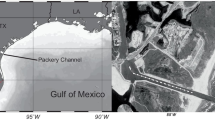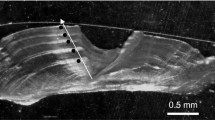Abstract
Tomcod (Microgadus tomcod) in the St. Lawrence estuarine transition zone (ETZ) undergo an ontogenetic habitat shift. Older age classes, characterised by a male-dominated sex ratio, disperse downstream over the summer months to occupy the colder more saline waters of the estuary. Significant differences in length and mass along the salinity gradient were observed in September with upstream fish of any given age class generally exhibiting greater growth. These differences were not seen in early summer. Benthic amphipod δ 34S signatures were strongly correlated with salinity and served to demonstrate that tomcod δ 34S signatures were not in isotopic equilibrium in the more saline waters of the ETZ. Seasonal distributional patterns, growth dynamics and isotopic disequilibrium all indicate that the observed habitat shift may occur on an annual basis, following winter aggregation in warmer, less saline waters. Tomcod located in the downstream parts of the ETZ, predominantly males, were significantly more sexually developed than upstream tomcod for a given age. On the other hand, greater growth early in life is insured by occupying warmer, upstream waters during the summer months.





Similar content being viewed by others
References
Attrill, M.J., and S.D. Rundle. 2002. Ecotone or ecocline: ecological boundaries in estuaries. Estuarine, Coastal and Shelf Science 55: 929–936.
Barton, M. 2007. Bond's biology of fishes, 3rd ed, 891. Belmont: Thomson. Toronto.
Bergeron, N., A.G. Roy, D. Chaumont, Y. Mailhot, and E. Guay. 1998. Winter geomorphological processes in the Sainte Anne River (Québec) and their impact on the migratory behavior of Atlantic tomcod (Microgadus tomcod). Regulated rivers: Research and management 14: 99–105.
Björnsson, B., A. Steinarsson, and M. Oddgeirsson. 2001. Optimal temperature for growth and feed conversion of immature cod (Gadus morhua L.). ICES Journal of Marine Science 58: 29–38.
Bourget, E. 1997. Les animaux littoraux du Saint-Laurent: guide d'identification. Québec: Presses Université Laval.
Bousfield, E.L. 1973. Shallow water gammaridean amphipoda of New England. London: Comstock.
Boy, C.C., A.F. Perez, D.A. Fernandez, J. Calvo, and E.R. Morriconi. 2009. Energy allocation in relation to spawning and overwintering of a diadromous Puyen (Galaxias maculatus) population in the southernmost limit of the species distribution. Polar Biology 32: 9–14.
Brodersen, J., P.A. Nilsson, L.A. Hansson, C. Skov, and C. Bronmark. 2008. Condition-dependent individual decision-making determines cyprinid partial migration. Ecology 89: 1195–1200.
Brunel, P., L. Bossé, and G. Lamarche. 1998. Catalogue of the marine invertebrates of the estuary and gulf of Saint Lawrence. Canadian Special Publication of Fisheries and Aquatic Sciences 126: 405.
Buchheister, A., and R.J. Latour. 2010. Turnover and fractionation of carbon and nitrogen stable isotopes in tissues of a migratory coastal predator, summer flounder (Paralichthys dentatus). Canadian Journal of Fisheries and Aquatic Sciences 67: 445–446.
Carlson, E.A., N.K. Roy, and I.I. Wirgin. 2009. Microarray analysis of polychlorinated biphenyl mixture-induced changes in gene expression among Atlantic tomcod populations displaying differential sensitivity to halogenated aromatic hydrocarbons. Environmental Toxicology and Chemistry 28: 759–771.
Dew, C.B., and J.H. Hecht. 1994. Hatching, estuarine transport, and distribution of larval and early juvenile Atlantic tomcod, Microgadus tomcod, in the Hudson river. Estuaries 17: 472–488.
Efron, B., and R.J. Tibshirani. 1993. An introduction to the bootstrap. New York: Chapman & Hall.
Fonds, M., R. Cronie, A.D. Vethaak, and P. Vanderpuyl. 1992. Metabolism, food consumption and growth of plaice (Pleuronectes platessa) and flounder (Platichthys flesus) in relation to fish size and temperature. Netherlands Journal of Sea Research 29(1–3): 127–143.
Frenette, J.J., W.F. Vincent, J.J. Dodson, and C. Lovejoy. 1995. Size dependent variations in phytoplankton and protozoan community structure across the St. Lawrence River transition region. Marine Ecology Progress Series 120: 99–110.
Fry, B. 2002. Conservative mixing of stable isotopes across estuarine salinity gradients: a conceptual framework for monitoring watershed influences on downstream fisheries production. Estuaries 25: 264–271.
Godbout, L., M. Trudel, J.R. Irvine, C.C. Wood, M.J. Grove, A.K. Schmitt, and K.D. McKeegan. 2010. Sulphur isotopes in otoliths allow discrimination of anadromous and non-anadromous ecotypes of sockeye salmon (Oncorhynchus nerka). Environmental Biology of Fishes 89: 521–532.
Herzka, S. 2005. Assessing connectivity of estuarine fishes based on stable isotope ratios analysis. Estuarine, Coastal and Shelf Science 64: 58–69.
Hesslein, R.H., M.J. Capel, D.E. Fox, and K.A. Hallard. 1991. Stable isotopes of sulphur, carbon, and nitrogen as indicators of trophic level and fish migration in the Bower Mackenzie River basin, Canada. Canadian Journal of Fisheries and Aquatic Sciences 48: 2258–2265.
Hesslein, R.H., K.A. Hallard, and P. Ramlal. 1993. Replacement of sulphur, carbon and nitrogen in tissue of growing broad whitefish (Coregonus nasus) in response to a change in diet traced by δ 34S, δ 13C, δ 15N. Canadian Journal of Fisheries and Aquatic Sciences 50: 2071–2076.
Holdway, D.A., and F.W.H. Beamish. 1984. Specific growth rate and body composition of Atlantic cod (Gadus morhua). Journal of Experimental Marine Biology and Ecology 81: 147–170.
Holmes, S.J. 1905. The amphipoda of southern New England. Woods Hole: Bulletin of the Bureau of Fisheries.
Huntingford, F.A., S. Chellappa, A.C. Taylor, and R.H.C. Strang. 2001. Energy reserves and reproductive investment in male three-spined sticklebacks, Gasterosteus aculeatus. Ecology of Freshwater Fish 10: 111–117.
Jonsson, B., and N. Jonsson. 1993. Partial migration: niche shift versus sexual maturation in fishes. Reviews in Fish Biology and Fisheries 3: 348–365.
Kerr, L.A., D.H. Secor, and P.M. Piccoli. 2009. Partial migration of fishes as exemplified by the estuarine-dependent white perch. Fisheries 34: 114–123.
Kitamura, T., M. Kume, H. Takahashi, and A. Goto. 2006. Juvenile bimodal length distribution and sea-run migration of the lower modal group in the Pacific Ocean form of three-spined stickleback. Journal of Fish Biology 69: 1245–1250.
Knudsen, R., A. Klemetsen, P.A. Amundsen, and B. Hermansen. 2006. Incipient speciation through niche expansion: an example from the Arctic charr in a subarctic lake. Proceedings of the Royal Society B-Biological Sciences 273: 2291–2298.
Lambert, Y., and G.J. Fitzgerald. 1979. Summer food and movements of the Atlantic tomcod Microgadus tomcod (Walbaum) in a small tidal creek. Naturaliste Canadien 106: 555–559.
Laprise, R., and J.J. Dodson. 1990. The mechanism of retention of larval and juvenile tomcod (Microgadus tomcod) in the turbid and well-mixed part of the St. Lawrence Estuary. Environmental Biology of Fishes 29: 293–302.
Laprise, R., and J.J. Dodson. 1989. Ontogenetic changes in the horizontal distribution of two species of larval fish in a turbid well-mixed estuary. Journal of Fish Biology 35(A): 39–47.
Lecomte, F., and J.J. Dodson. 2005. Distinguishing trophic and habitat partitioning among sympatric populations of the estuarine fish Osmerus mordax Mitchill. Journal of Fish Biology 66: 1601–1623.
Love, R.M. 1970. Chemical biology of fishes: with a key to chemical literature. London: Academic.
Maruyama, A., Y. Yamada, B. Rusuwa, and M. Yuma. 2001. Change in stable nitrogen isotope ratio in the muscle tissue of a migratory goby, Rhinogobius sp., in a natural setting. Canadian Journal of Fisheries and Aquatic Sciences 58: 2125–2128.
McCutchan, J.H., W.M. Lewis, C. Kendall, and C.C. McGrath. 2003. Variation in trophic shift for stable isotope ratios of carbon, nitrogen, and sulphur. Oikos 102: 378–390.
Moon, H.Y., and D.M. Gatlin. 1991. Total sulphur amino acid requirement of juvenile red drum, Sciaenops ocellatus. Aquaculture 95: 97–106.
Rasmussen, J.B., V. Trudeau, and G. Morinville. 2009. Estimating the scale of fish feeding movements in rivers using delta C-13 signature gradients. Journal of Animal Ecology 78: 674–685.
Rubenstein, D.R., and K.A. Hobson. 2004. From birds to butterflies: animal movement patterns and stable isotopes. Trends in Ecology & Evolution 19: 256–263.
Sakano, H., E. Fujiwara, S. Nohara, and H. Ueda. 2005. Estimation of nitrogen stable isotope turnover rate of Oncorhynchus nerka. Environmental Biology of Fishes 72: 13–18.
Santic, M., I. Mikulandra, A. Pallaoro, I. Jardas, and N. Staglicic. 2009. Diet of poor cod, Trisopterus minutus (Osteichthyes: Gadidae) from the eastern central Adriatic Sea. Cahiers de Biologie Marine 50: 183–192.
Sars, G.O. 1895. An account of the crustacea of Norway with short descriptions and figures of all the species. Vol. 1, Amphipodes. Christiania and Copenhagen, A. Cammermeyer Forlag, Christiniana, Norway
Scott, W.B., and E.J. Crossman. 1974. Poissons d'eau douce du Canada. Ottawa: Ministère de l'Environnement.
Tzeng, W.N. 1996. Effects of salinity and ontogenetic movements on strontium:calcium ratios in the otoliths of the Japanese eel, Anguilla japonica Temmink and Schlegel. Journal of Experimental Marine Biology and Ecology 199: 111–122.
Vincent, W.F., and J.J. Dodson. 1999. The St. Lawrence River, Canada USA: the need for an ecosystem level understanding of large rivers. Japanese Journal of Limnology 60: 29–50.
Werner, E.E., and J.F. Gilliam. 1984. The ontogenetic niche and species interactions in size-structured populations. Annual Review of Ecology and Systematics 15: 393–425.
Winkler, G., J.J. Dodson, N. Bertrand, D. Thivierge, and W.F. Vincent. 2003. Trophic coupling across the St. Lawrence River estuarine transition zone. Marine Ecology Progress Series 251: 59–73.
Yuan, Z.P., S. Courtenay, and I. Wirgin. 2006. Comparison of hepatic and extra hepatic induction of cytochrome P4501A by graded doses of aryl hydrocarbon receptor agonists in Atlantic tomcod from two populations. Aquatic Toxicology 76(3–4): 306–320.
Acknowledgements
We thank the captains and crew of the RV Lampsilis, especially François Harvey, Luc Harvey, Louis-Philippe Leclerc, Louise Lemay, Luc Lavoie and Sylvie Boutin. We also thank Andreanne Paris, Catherine Brisson-Bonenfant, Charlene Lavallee, Jean-François Bourque, Jean Francois Dery, Marie-Andree Godbout and Gesche Winkler for assistance on board and in the laboratory. We thank Daniel Dolan for validating the ageing of Atlantic tomcod, Yves Mailhot and Pierre Pettigrew for their knowledge of the species and the otolith preparation method. Isabel Thibault, François Martin, David Paez, Geneviève Parent, Marie-Claude Gagnon, Gabriel Colbeck, Simon Pineault, Louis Rocheleau-Lieutenant, Michel Belanger, Julie Turgeon and Warwick F. Vincent provided helpful comments during project development and the writing of the manuscript. This study was made possible by grants from the Canadian Natural Sciences and Engineering Research Council, Discovery Grant and ship-time programmes and by infrastructural support from the Université du Québec à Trois Rivières and Quebec-Ocean.
Author information
Authors and Affiliations
Corresponding author
Rights and permissions
About this article
Cite this article
Couillard, M.A., Cabana, G., Dery, J.F. et al. Ontogenetic Habitat Shifts of the Atlantic Tomcod (Microgadus tomcod) Across an Estuarine Transition Zone. Estuaries and Coasts 34, 1234–1245 (2011). https://doi.org/10.1007/s12237-011-9428-0
Received:
Revised:
Accepted:
Published:
Issue Date:
DOI: https://doi.org/10.1007/s12237-011-9428-0




